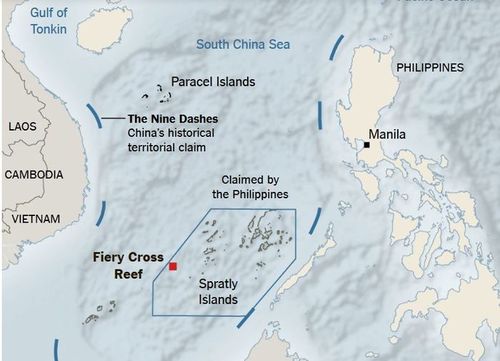
Pat Buchanan: Is a Korean Missile Crisis Ahead?
03/09/2017
To back up Defense Secretary "Mad Dog" Mattis' warning last month, that the U.S. "remains steadfast in its commitment" to its allies, President Donald Trump is sending B-1 and B-52 bombers to Korea.
Some 300,000 South Korean and 15,000 U.S. troops have begun their annual Foal Eagle joint war exercises that run through April.
"The two sides are like two accelerating trains coming toward each other with neither side willing to give way," says Chinese Foreign Minister Wang Yi, "Are (they) really ready for a head-on collision?"
So it would seem.
It is Kim Jong Un, 33-year-old grandson of that Stalinist state’s founding father, who launched the first Korean War, who brought on this confrontation.
In February, Kim’s half-brother was assassinated in Malaysia in a VX nerve agent attack and five of Kim’s security officials were executed with anti-aircraft guns. Monday, Kim launched four missiles toward U.S. bases, with three landing in the Sea of Japan.
U.S. response: Begin immediate deployment of the Terminal High Altitude Area Defense missile shield in Korea.
This set off alarms in China. For while THAAD cannot shoot down Scuds on the DMZ, its radar can detect missile launches inside China, thereby, says Beijing, imperiling her deterrent.
For accepting THAAD, China has imposed sanctions on Seoul, and promised the U.S. a commensurate strategic response.
Minister Wang’s proposal for resolving the crisis: The U.S. and Seoul cancel the exercises and North Korea suspends the nuclear and missile tests.
How did we reach this crisis point?
In his 2002 "axis of evil" address, George W. Bush declared, "The United States … will not permit the world’s most dangerous regimes to threaten us with the world’s most destructive weapons."
He then launched a war on Iraq, which had no such weapons. But North Korea, hearing Bush’s threat, built and tested five atom bombs and scores of missiles, a few of intercontinental range.

Pyongyang has tested new presidents before.
In April 1969, North Korea shot down a U.S. EC-121 over the Sea of Japan, killing its entire crew. President Nixon, a war in Vietnam on his hands, let it pass, which he regretted ever after.
But this crisis raises larger questions about U.S. foreign policy.
Why, a quarter of a century after the Cold War, do we still have 28,000 troops in Korea? Not only does South Korea have twice the population of the North, but an economy 40 times as large, and access to U.S. weapons far superior to any in the North.
Why should Americans on the DMZ be among the first to die in a second Korean War? Should the North attack the South, could we not honor our treaty obligations with air and naval power offshore?
Gen. James Mattis' warning last month was unambiguous:
"Any attack on the United States or our allies will be defeated and any use of nuclear weapons would be met with a response that would be effective and overwhelming."
JFK’s phrase in the Cuban crisis, "full retaliatory response," comes to mind.
Hence the next move is up to Kim.
New tests by North Korea of missiles or atom bombs for an ICBM could bring U.S. strikes on its nuclear facilities and missile sites, igniting an attack on the South.
For China, this crisis, whether it leads to war, a U.S. buildup in the South, or a U.S. withdrawal from Korea, is problematic.
Beijing cannot sit by and let her North Korean ally be bombed, nor can it allow U.S. and South Korean forces to defeat the North, bring down the regime, and unite the peninsula, with U.S. and South Korean soldiers sitting on the Yalu, as they did in 1950 before Mao ordered his Chinese army into Korea.
However, should U.S. forces withdraw from the South, Seoul might build her own nuclear arsenal, followed by Japan. For Tokyo could not live with two Koreas possessing nukes, while she had none.
This could leave China contained by nuclear neighbors: to the north, Russia, to the south, India, to the east, South Korea and Japan. And America offshore.
What this crisis reveals is that China has as great an interest in restraining North Korea as do we.
While the United States cannot back down, it is difficult to reconcile a second Korean war with our America First policy. Which is why some of us have argued for decades that the United States should moves its forces out of South Korea and off the Asian continent.

Events in Asia — Chinese claims to reefs and rocks in the South and East China Seas and North Korea’s menacing her neighbors — are pushing us toward a version of the Nixon Doctrine declared in Guam in 1969 that is consistent with America first:
While we will provide the arms for friends and allies to fight in their own defense in any future wars, henceforth, they will provide the troops.
Patrick J. Buchanan needs no introduction to VDARE.com readers; his books State of Emergency: The Third World Invasion and Conquest of America, and Suicide of a Superpower: Will America Survive to 2025? are available from Amazon.com. Patrick J. Buchanan is the author of the new book “The Greatest Comeback: How Richard Nixon Rose From Defeat to Create the New Majority.“

![51-sjuXJb6L[1]](/wp-content/uploads/2014/07-sjuXJb6L1-198x300.jpg)